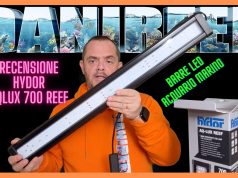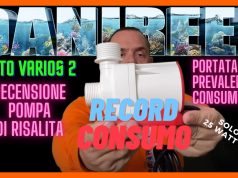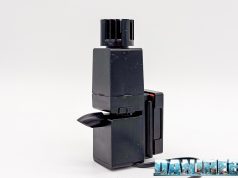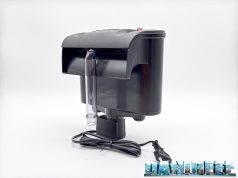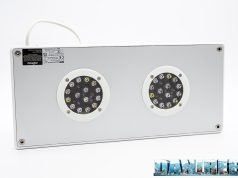After three months of trial, we’re finally here with our usual review for the Rossmont Riser 3200 return pump which we introduced in this article.
This article is also available in: ![]() italiano
italiano
Rossmont Riser‘s peculiarity is that it is an alternating current non electronic pump, but it can become adjustable if paired with the Rossmont Waver (review).
We measured prevalence, flow rate and consumption. We did so without pairing the pump with its Waver controller, and thus we only measured the maximum values. Considering the controller category, there aren’t actually predetermined values for flow rate and head max, but it’s possible to adjust the pump on every pair of flow rate and head values, and that’s why we chose to measure only the maximum value.
Concerning head max we used the usual flawless static method. Regarding flow rate, we used the DigiFlow 6710M flowmeter and for consumption we used RCE PM600.
Rossmont Riser 3200 Technical Characteristics
| European Version 230 V – 50 Hz |
American Version 120 V – 60 Hz |
|
| Flow rate: | 3.200 l/h | 850 gph |
| Consumption: | 52 watt | 55 watt |
| Head max: | 2,9 metri | 115 in |
| Width: | 12,5 cm | 4.93 in |
| Depth: | 8 cm | 3.15 in |
| Height: | 12,7 cm | 5.00 in |
| Price: | 114,90 euros | 99 USD + VAT |
The Rossmont Riser 3200 shows on paper an energy efficiency equal to 61,54 litres per every consumed watt. An economic efficiency equal to 27,85 litres per second per euro and thus a reference value of 4.640 l*m/h.
At a relatively low cost of 114,90 euros we can acquire a great pump, which starts with fixed flow rate and prevalence, but you only have to add the Rossmont Waver for it to fly high and transform into an adjustable, hyper modern pump. The economic efficiency is good, as far as we consider the Waver, whereas the technical efficiency is ordinary. This at least on paper. But now let’s see what we have measured and how it gets included in the values that we have measured up to date for every other pump (on page 3). At present, it’s the pump I use for my aquarium.
The construct
The pump is simple. Squared. In a two-tone black and white livery.
Inside the packaging you can find the pump and a pair of identical hose connectors. The hose connectors can be sectioned based on their own return pump ‘s diameter. The water entry and exit can measure from 3/4 of an inch up to one inch depending on whether you use the hose connectors or you decide to cut them.
We immediately proceeded to disassemble the pump to see how its impeller was built.
The impeller has a traditional form, and 6 straight blades, which rotate around a ceramic shaft, held by the two traditional pads. Dimensions are not too big.
How to control the Riser pump with the Waver
This pump’s main characteristic, as we said, is that if used as a stand-alone it’s a very normal alternating current pump. But when you pair it with a Waver (review), the pump becomes extremely adjustable and ductile.
Using the controller’s logics it’s possible to vary the flow rate during the day; moreover, something I find extremely useful, it’s possible to calibrate the pump. Through this modality you can tell the pump how much power has to be used from the pump so that the flow rate between the sump and the tank is absolutely equal to zero. This way you are able to feed your own animals in the aquarium without there being any type of flow, but without the sump getting full of water. A function that, needless to say, I really like. It’s not a new function, in any case, but that I know of, only Ecotech Marine implements it on its Vectra.
Of course, you have to pay attention because when you activate this function, the water level in the aquarium drops a bit; it’s absolutely normal. But it becomes priceless when at night I find myself feeding my corals through the pipette whilst all the pumps are turned off and without having the sump become full with the water arriving from the tank.
As for the rest, it’s possible to configure the pump at a specific flow rate in every single moment of the day. Without being constrained by fixed flow rates. I can choose the one I prefer with my finger on the chart.
You can find all of our measurements on page 2












